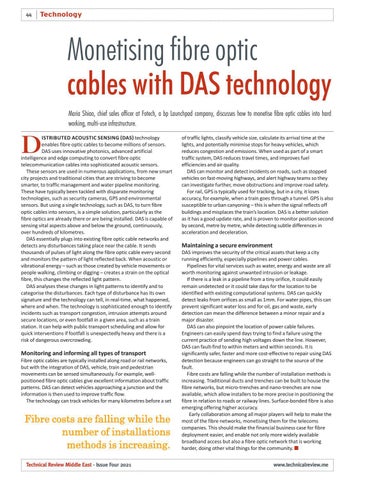S12 TRME 4 2021 Country Focus_Layout 1 28/09/2021 15:27 Page 44
44
Technology
Monetising fibre optic cables with DAS technology Maria Shiao, chief sales officer at Fotech, a bp Launchpad company, discusses how to monetise fibre optic cables into hard working, multi-use infrastructure. ISTRIBUTED ACOUSTIC SENSING (DAS) technology enables fibre optic cables to become millions of sensors. DAS uses innovative photonics, advanced artificial intelligence and edge computing to convert fibre optic telecommunication cables into sophisticated acoustic sensors. These sensors are used in numerous applications, from new smart city projects and traditional cities that are striving to become smarter, to traffic management and water pipeline monitoring. These have typically been tackled with disparate monitoring technologies, such as security cameras, GPS and environmental sensors. But using a single technology, such as DAS, to turn fibre optic cables into sensors, is a simple solution, particularly as the fibre optics are already there or are being installed. DAS is capable of sensing vital aspects above and below the ground, continuously, over hundreds of kilometres. DAS essentially plugs into existing fibre optic cable networks and detects any disturbances taking place near the cable. It sends thousands of pulses of light along the fibre optic cable every second and monitors the pattern of light reflected back. When acoustic or vibrational energy – such as those created by vehicle movements or people walking, climbing or digging – creates a strain on the optical fibre, this changes the reflected light pattern. DAS analyses these changes in light patterns to identify and to categorise the disturbances. Each type of disturbance has its own signature and the technology can tell, in realtime, what happened, where and when. The technology is sophisticated enough to identify incidents such as transport congestion, intrusion attempts around secure locations, or even footfall in a given area, such as a train station. It can help with public transport scheduling and allow for quick interventions if footfall is unexpectedly heavy and there is a risk of dangerous overcrowding.
D
Monitoring and informing all types of transport Fibre optic cables are typically installed along road or rail networks, but with the integration of DAS, vehicle, train and pedestrian movements can be sensed simultaneously. For example, well positioned fibre optic cables give excellent information about traffic patterns. DAS can detect vehicles approaching a junction and the information is then used to improve traffic flow. The technology can track vehicles for many kilometres before a set
Fibre costs are falling while the number of installations methods is increasing. Technical Review Middle East - Issue Four 2021
of traffic lights, classify vehicle size, calculate its arrival time at the lights, and potentially minimise stops for heavy vehicles, which reduces congestion and emissions. When used as part of a smart traffic system, DAS reduces travel times, and improves fuel efficiencies and air quality. DAS can monitor and detect incidents on roads, such as stopped vehicles on fastmoving highways, and alert highway teams so they can investigate further, move obstructions and improve road safety. For rail, GPS is typically used for tracking, but in a city, it loses accuracy, for example, when a train goes through a tunnel. GPS is also susceptible to urban canyoning – this is when the signal reflects off buildings and misplaces the train’s location. DAS is a better solution as it has a good update rate, and is proven to monitor position second by second, metre by metre, while detecting subtle differences in acceleration and deceleration.
Maintaining a secure environment DAS improves the security of the critical assets that keep a city running efficiently, especially pipelines and power cables. Pipelines for vital services such as water, energy and waste are all worth monitoring against unwanted intrusion or leakage. If there is a leak in a pipeline from a tiny orifice, it could easily remain undetected or it could take days for the location to be identified with existing computational systems. DAS can quickly detect leaks from orifices as small as 1mm. For water pipes, this can prevent significant water loss and for oil, gas and waste, early detection can mean the difference between a minor repair and a major disaster. DAS can also pinpoint the location of power cable failures. Engineers can easily spend days trying to find a failure using the current practice of sending high voltages down the line. However, DAS can faultfind to within meters and within seconds. It is significantly safer, faster and more costeffective to repair using DAS detection because engineers can go straight to the source of the fault. Fibre costs are falling while the number of installation methods is increasing. Traditional ducts and trenches can be built to house the fibre networks, but microtrenches and nanotrenches are now available, which allow installers to be more precise in positioning the fibre in relation to roads or railway lines. Surfacebonded fibre is also emerging offering higher accuracy. Early collaboration among all major players will help to make the most of the fibre networks, monetising them for the telecoms companies. This should make the financial business case for fibre deployment easier, and enable not only more widely available broadband access but also a fibre optic network that is working harder, doing other vital things for the community. ■ www.technicalreview.me











